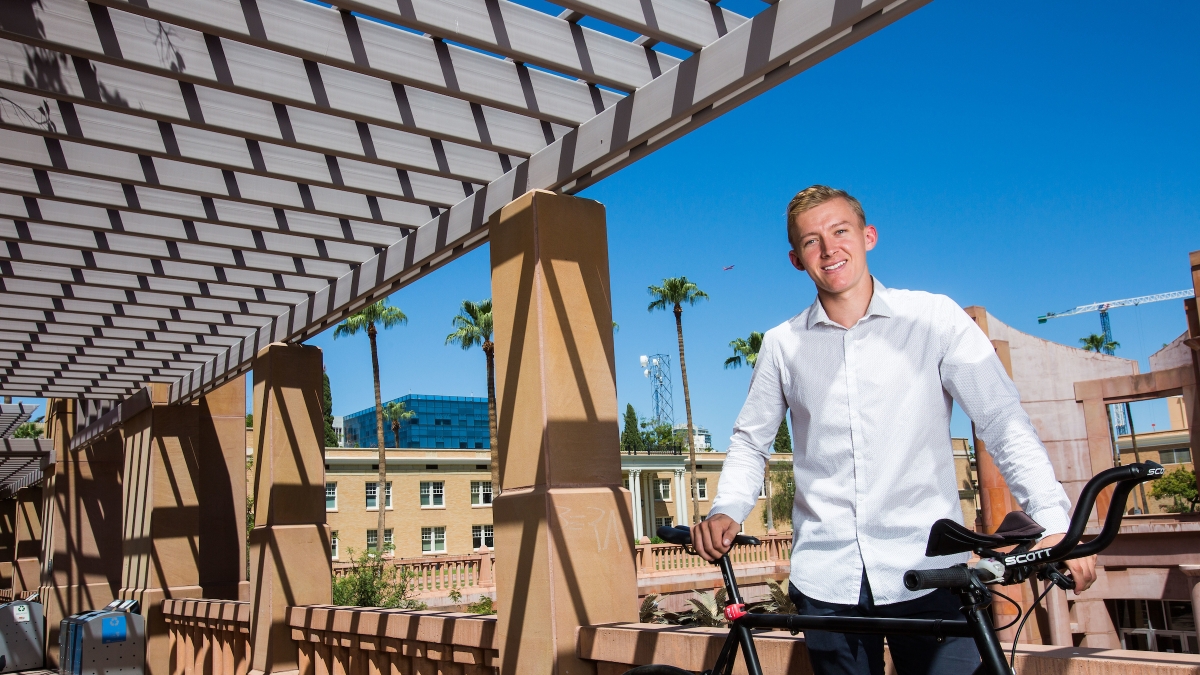ASU student on Tesla wait list is driven by innovation and sustainability
Electric-car manufacturer has a challenging model, ASU supply-chain professor says

The Tesla Model 3 is a game changer — a high-style, affordable car that runs on electricity.
More than half a million people are on the waiting list for the Model 3, and it only seems logical that a student at the most innovative university in the country is in line to get one of the most pioneering cars in history.
After making a splash this summer by delivering a handful of the new Model 3 cars, Tesla is now working to ramp up its manufacturing — with everyone watching to see how the experiment plays out.
Truman Hale, a junior sustainability business major at Arizona State University, put his $1,000 deposit on the Tesla Model 3 when he was still in high school and expects to see the car in his driveway by the time he graduates in December 2018.
“It wasn’t a huge decision at the time, but over the years I started realizing how huge of an issue climate change is. And Tesla is more than a company, it’s a cause. That drove me to be super committed to this car,” he said.
Hale has lived a thrifty lifestyle to save up for the Model 3, which costs $35,000. He has worked multiple jobs, rarely eats out, carefully weighs every purchase and lives at home. Most importantly, he rides his bike everywhere, not only to save money but also to lighten his carbon footprint.
“I was fascinated by the fact that the car was running on electricity and that you can charge it on a wall plug,” said Hale, who saw the original Tesla cars on the TV show “Top Gear” and then researched the company for a marketing class at Saguaro High School in Scottsdale, Arizona. He decided then to save up for the Model 3, the mass-market version that was still years away at that point. The earlier Tesla cars start at about $70,000 and can cost $100,000 with extras.
Hale actually started out majoring in software engineering so he could work at Tesla on self-driving cars, but later changed to business sustainability.
“I still would love to work for Tesla,” he said.
As a business major, Hale is especially appreciative of the Tesla mission.
“It’s more than just cars. They’re doing sustainable transport, solar, energy storage and self-driving cars,” he said.
“The fact that they’re disrupting the industry with something that’s totally unique is an incredible feat.”
While more than 500,000 people are waiting to buy a Model 3 — and only about 30 have been delivered to the company’s employees — the company’s unique supply-chain model is unproven, according to Dale Rogers, a professor of logistics and supply chain management at the W. P. Carey School of Business.
“Tesla is still a relatively new company, and we’ve been so thankful that they’ve hired several of our students out of ASU supply chain,” said Rogers, who is also co-director of the Internet Edge Supply Chain Lab in W. P. Carey.
“I admire the amount of innovation they’re putting into it, but it’s hard to be a pioneer. Finding sources of supply is harder for them than for companies that do this with a combustion engine,” he said.
Also, many car manufacturers outsource their suppliers while Tesla does not, instead forming a partnership to operate its battery factory.
“The other thing is that Tesla has chosen strategically to not have dealers,” he said. This means that Tesla owns the car until the consumer drives it away — far longer than companies that use dealers.
All of those aspects can be very expensive for the company.
“Your cash-to-cash cycle is longer,” Rogers said. “It may end up brilliant, but it may not be.”
Dealers also are politically powerful.
“It’s not accidental that some states have banned the direct sales of Tesla,” he said.
As someone who has studied supply chains for decades, Rogers has seen innovation before.
“At the end of my street there’s a DeLoreanThe DeLorean Motor Company manufactured a stainless-steel sports car with gull-wing doors featured in the “Back to the Future” movies in the early 1980s before going bankrupt in 1985. and that was a really disruptive model as well,” he said. “The car industry took some good ideas away from John DeLorean, although it didn’t last.
“Tesla is different, but its model is challenging.”
Hale is a believer in the company, having invested some of his savings into Tesla stock.
“It’s not the material thing that I’m saving up for, it’s the vision behind it.”
5 money-saving tips for students from Truman Hale
Video by Deanna Dent/ASU Now
Top photo: Junior Truman Hale put a $1,000 deposit on a Tesla Model 3 while he was still in high school and has been riding his bike for transportation since then. He expects to receive the car next year, when he'll receive a degree in business sustainability. Photo by Deanna Dent/ASU Now
More Science and technology

ASU author puts the fun in preparing for the apocalypse
The idea of an apocalypse was once only the stuff of science fiction — like in “Dawn of the Dead” or “I Am Legend.” However these days, amid escalating global conflicts and the prospect of a nuclear…

Meet student researchers solving real-world challenges
Developing sustainable solar energy solutions, deploying fungi to support soils affected by wildfire, making space education more accessible and using machine learning for semiconductor material…

Miss Arizona, computer science major wants to inspire children to combine code and creativity
Editor’s note: This story is part of a series of profiles of notable spring 2024 graduates. “It’s bittersweet.” That’s how Tiffany Ticlo describes reaching this milestone. In May, she will graduate…